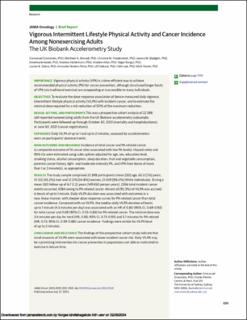| dc.description.abstract | Importance: Vigorous physical activity (VPA) is a time-efficient way to achieve recommended physical activity (PA) for cancer prevention, although structured longer bouts of VPA (via traditional exercise) are unappealing or inaccessible to many individuals.
Objectives: To evaluate the dose-response association of device-measured daily vigorous intermittent lifestyle physical activity (VILPA) with incident cancer, and to estimate the minimal dose required for a risk reduction of 50% of the maximum reduction.
Design, Setting, and Participants: This was a prospective cohort analysis of 22 398 self-reported nonexercising adults from the UK Biobank accelerometry subsample. Participants were followed up through October 30, 2021 (mortality and hospitalizations), or June 30, 2021 (cancer registrations).
Exposures: Daily VILPA of up to 1 and up to 2 minutes, assessed by accelerometers worn on participants’ dominant wrist.
Main Outcomes and Measures: Incidence of total cancer and PA-related cancer (a composite outcome of 13 cancer sites associated with low PA levels). Hazard ratios and 95% CIs were estimated using cubic splines adjusted for age, sex, education level, smoking status, alcohol consumption, sleep duration, fruit and vegetable consumption, parental cancer history, light- and moderate-intensity PA, and VPA from bouts of more than 1 or 2 minute(s), as appropriate.
Results: The study sample comprised 22 398 participants (mean [SD] age, 62.0 [7.6] years; 10 122 [45.2%] men and 12 276 [54.8%] women; 21 509 [96.0%] White individuals). During a mean (SD) follow-up of 6.7 (1.2) years (149 650 person-years), 2356 total incident cancer events occurred, 1084 owing to PA-related cancer. Almost all (92.3%) of VILPA was accrued in bouts of up to 1 minute. Daily VILPA duration was associated with outcomes in a near-linear manner, with steeper dose-response curves for PA-related cancer than total cancer incidence. Compared with no VILPA, the median daily VILPA duration of bouts up to 1 minute (4.5 minutes per day) was associated with an HR of 0.80 (95% CI, 0.69-0.92) for total cancer and 0.69 (95% CI, 0.55-0.86) for PA-related cancer. The minimal dose was 3.4 minutes per day for total (HR, 0.83; 95% CI, 0.73-0.93) and 3.7 minutes for PA-related (HR, 0.72; 95% CI, 0.59-0.88) cancer incidence. Findings were similar for VILPA bout of up to 2 minutes.
Conclusions and Relevance: The findings of this prospective cohort study indicate that small amounts of VILPA were associated with lower incident cancer risk. Daily VILPA may be a promising intervention for cancer prevention in populations not able or motivated to exercise in leisure time. | en_US |


